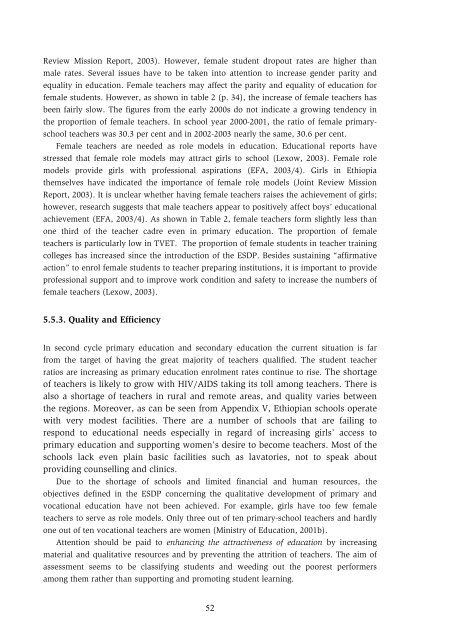Education and Training in Ethiopia An Evaluation of Approaching EFA Goals
Education and Training in Ethiopia - Koulutuksen tutkimuslaitos
Education and Training in Ethiopia - Koulutuksen tutkimuslaitos
- No tags were found...
You also want an ePaper? Increase the reach of your titles
YUMPU automatically turns print PDFs into web optimized ePapers that Google loves.
Review Mission Report, 2003). However, female student dropout rates are higher thanmale rates. Several issues have to be taken <strong>in</strong>to attention to <strong>in</strong>crease gender parity <strong>and</strong>equality <strong>in</strong> education. Female teachers may affect the parity <strong>and</strong> equality <strong>of</strong> education forfemale students. However, as shown <strong>in</strong> table 2 (p. 34), the <strong>in</strong>crease <strong>of</strong> female teachers hasbeen fairly slow. The figures from the early 2000s do not <strong>in</strong>dicate a grow<strong>in</strong>g tendency <strong>in</strong>the proportion <strong>of</strong> female teachers. In school year 2000-2001, the ratio <strong>of</strong> female primaryschoolteachers was 30.3 per cent <strong>and</strong> <strong>in</strong> 2002-2003 nearly the same, 30.6 per cent.Female teachers are needed as role models <strong>in</strong> education. <strong>Education</strong>al reports havestressed that female role models may attract girls to school (Lexow, 2003). Female rolemodels provide girls with pr<strong>of</strong>essional aspirations (<strong>EFA</strong>, 2003/4). Girls <strong>in</strong> <strong>Ethiopia</strong>themselves have <strong>in</strong>dicated the importance <strong>of</strong> female role models (Jo<strong>in</strong>t Review MissionReport, 2003). It is unclear whether hav<strong>in</strong>g female teachers raises the achievement <strong>of</strong> girls;however, research suggests that male teachers appear to positively affect boys’ educationalachievement (<strong>EFA</strong>, 2003/4). As shown <strong>in</strong> Table 2, female teachers form slightly less thanone third <strong>of</strong> the teacher cadre even <strong>in</strong> primary education. The proportion <strong>of</strong> femaleteachers is particularly low <strong>in</strong> TVET. The proportion <strong>of</strong> female students <strong>in</strong> teacher tra<strong>in</strong><strong>in</strong>gcolleges has <strong>in</strong>creased s<strong>in</strong>ce the <strong>in</strong>troduction <strong>of</strong> the ESDP. Besides susta<strong>in</strong><strong>in</strong>g “affirmativeaction” to enrol female students to teacher prepar<strong>in</strong>g <strong>in</strong>stitutions, it is important to providepr<strong>of</strong>essional support <strong>and</strong> to improve work condition <strong>and</strong> safety to <strong>in</strong>crease the numbers <strong>of</strong>female teachers (Lexow, 2003).5.5.3. Quality <strong>and</strong> EfficiencyIn second cycle primary education <strong>and</strong> secondary education the current situation is farfrom the target <strong>of</strong> hav<strong>in</strong>g the great majority <strong>of</strong> teachers qualified. The student teacherratios are <strong>in</strong>creas<strong>in</strong>g as primary education enrolment rates cont<strong>in</strong>ue to rise. The shortage<strong>of</strong> teachers is likely to grow with HIV/AIDS tak<strong>in</strong>g its toll among teachers. There isalso a shortage <strong>of</strong> teachers <strong>in</strong> rural <strong>and</strong> remote areas, <strong>and</strong> quality varies betweenthe regions. Moreover, as can be seen from Appendix V, <strong>Ethiopia</strong>n schools operatewith very modest facilities. There are a number <strong>of</strong> schools that are fail<strong>in</strong>g torespond to educational needs especially <strong>in</strong> regard <strong>of</strong> <strong>in</strong>creas<strong>in</strong>g girls’ access toprimary education <strong>and</strong> support<strong>in</strong>g women’s desire to become teachers. Most <strong>of</strong> theschools lack even pla<strong>in</strong> basic facilities such as lavatories, not to speak aboutprovid<strong>in</strong>g counsell<strong>in</strong>g <strong>and</strong> cl<strong>in</strong>ics.Due to the shortage <strong>of</strong> schools <strong>and</strong> limited f<strong>in</strong>ancial <strong>and</strong> human resources, theobjectives def<strong>in</strong>ed <strong>in</strong> the ESDP concern<strong>in</strong>g the qualitative development <strong>of</strong> primary <strong>and</strong>vocational education have not been achieved. For example, girls have too few femaleteachers to serve as role models. Only three out <strong>of</strong> ten primary-school teachers <strong>and</strong> hardlyone out <strong>of</strong> ten vocational teachers are women (M<strong>in</strong>istry <strong>of</strong> <strong>Education</strong>, 2001b).Attention should be paid to enhanc<strong>in</strong>g the attractiveness <strong>of</strong> education by <strong>in</strong>creas<strong>in</strong>gmaterial <strong>and</strong> qualitative resources <strong>and</strong> by prevent<strong>in</strong>g the attrition <strong>of</strong> teachers. The aim <strong>of</strong>assessment seems to be classify<strong>in</strong>g students <strong>and</strong> weed<strong>in</strong>g out the poorest performersamong them rather than support<strong>in</strong>g <strong>and</strong> promot<strong>in</strong>g student learn<strong>in</strong>g.52




![to read the full report [pdf, Amharic] - Ethiopian Review](https://img.yumpu.com/52737829/1/190x245/to-read-the-full-report-pdf-amharic-ethiopian-review.jpg?quality=85)











